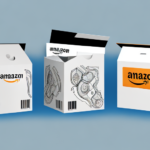Understanding Amazon's Pick and Pack Fees Explained
As an Amazon seller, it is crucial to have a comprehensive understanding of the platform's various fees, particularly the Pick and Pack fees. In this article, we will explain what Pick and Pack fees are and how they affect your profit margin. We'll also discuss the factors that determine the fees, how you can calculate them, and tips for reducing them. Additionally, we'll explore the differences between standard and oversize items, the impact of Pick and Pack fees on FBA versus FBM sellers, and how to negotiate lower fees with Amazon. Lastly, we'll provide best practices for managing your inventory to minimize Pick and Pack fees and give our predictions for the future of the Pick and Pack fee structure.
What are Amazon's Pick and Pack Fees?
Pick and Pack fees are charges levied by Amazon for the costs associated with fulfilling your orders. This fee covers picking items from the warehouse, packaging them, and shipping them to the customer. Essentially, Pick and Pack fees represent the operational costs incurred by Amazon to ensure your orders are delivered efficiently.
It's important to note that Pick and Pack fees vary depending on the size and weight of the item being shipped. For example, larger and heavier items incur higher fees due to the additional labor and materials required for packaging and shipping. Additionally, Amazon offers a fee calculator tool to help sellers estimate their Pick and Pack fees. Factoring in these fees when setting your prices is essential to maintaining profitability.
The Importance of Knowing Your Pick and Pack Fees
Amazon's fees can significantly impact your profitability, making it essential to understand all fees associated with your sales. Knowing your Pick and Pack fees allows you to accurately predict your overall fulfillment costs. By incorporating these costs into your pricing strategy, you can ensure profitability and avoid unexpected expenses.
Moreover, understanding your Pick and Pack fees helps identify areas where you can optimize your fulfillment process. For instance, if your Pick and Pack fees are higher than expected, consider reorganizing your inventory or adjusting your packaging to reduce the time and resources required for fulfillment. By continuously monitoring and analyzing your Pick and Pack fees, you can make informed decisions that will ultimately improve your bottom line.
How Pick and Pack Fees Affect Your Profit Margin
Understanding Pick and Pack fees and their impact on your profit margin is crucial. High Pick and Pack fees not accounted for in your pricing strategy may lead to lower-than-expected profits. Conversely, by integrating knowledge of these fees, you can adjust your fulfillment cost structure strategically, such as offering faster shipping options to customers.
It's important to note that Pick and Pack fees vary based on the size and weight of your products. Shipping larger or heavier items can result in higher fees compared to smaller items. Therefore, factoring in these costs when determining your pricing strategy is vital. Additionally, consider whether offering smaller, lighter products might be more cost-effective. By understanding the impact of Pick and Pack fees on your profit margin and making strategic adjustments, you can optimize your fulfillment process and enhance overall profitability.
The Factors That Determine Amazon's Pick and Pack Fees
Multiple factors influence Amazon's Pick and Pack fees, including:
- Item Size and Weight: Larger and heavier items generally incur higher fees.
- Category: Different product categories may have varying fee structures.
- Packaging Requirements: Specialized packaging can add to the fees.
- Shipping Destination: Domestic versus international destinations affect fees.
- Service Levels: Standard, Expedited, and other service levels can change the fee amounts.
Familiarizing yourself with these factors allows for more accurate calculation of your Pick and Pack fees. However, it is important to note that Amazon regularly updates its fee structure to reflect market changes and remain competitive. Staying up-to-date with these changes is crucial to avoid unexpected costs. Additionally, seasonal factors, such as increased order volumes during the holiday season, can lead to fee adjustments to account for the need for additional resources.
How to Calculate Your Pick and Pack Fees
Amazon provides a Pick and Pack Fee Calculator to help you determine your total fees. This tool accounts for item size, weight, category, and destination, providing an accurate estimate of your Pick and Pack fees. To access the calculator, log into your Amazon Seller account and navigate to the "Fees" tab.
Additionally, keep in mind that fees may fluctuate based on the time of year. During peak seasons, such as holidays, fees may be higher due to increased demand and shipping costs. Factoring in these potential fluctuations is important when calculating your fees and setting product prices.
Tips for Reducing Your Pick and Pack Fees
Implementing the following strategies can help reduce your Pick and Pack fees and increase overall profitability:
- Optimize Product Size and Weight: Reducing the size and weight of your products leads to lower fulfillment costs.
- Streamline Packaging: Using efficient packaging materials can cut costs.
- Consolidate Shipments: Combining multiple items per shipment lowers per-item Pick and Pack fees.
- Negotiate with Fulfillment Providers: Volume discounts or long-term contracts can result in reduced fees.
- Regularly Review Fees: Compare your current fees with other providers to ensure you're getting the best deal.
By adopting these strategies, you can significantly reduce your Pick and Pack fees and enhance your profitability.
Understanding the Difference Between Standard and Oversize Items
Amazon categorizes items into two main categories:
- Standard Items: Items that weigh less than one pound and fit in a box measuring less than eighteen inches in any dimension.
- Oversize Items: Items that exceed either the weight or size measurements of standard items.
Oversize items are subject to higher Pick and Pack fees due to the additional handling and transportation requirements. Accurate measurement and categorization of your products are crucial to avoid unexpected fees and shipping delays. Additionally, consider the packaging materials needed for oversize items, as they may require larger boxes or additional padding to ensure safe delivery.
How to Monitor Your Pick and Pack Fees for Accuracy
Amazon offers several tools to monitor your Pick and Pack fees. Access detailed reports by order, SKU, or ASIN through your Seller account. Regularly reviewing these reports ensures fee accuracy and helps identify any discrepancies.
Alongside Amazon's tools, maintain your own records of inventory and shipments to cross-reference with Amazon's reports. This practice ensures correct fee charges and helps identify any potential overcharges. Additionally, compare your fees to industry standards to better understand what you're paying and leverage this information to negotiate with Amazon or spot any irregularities.
The Impact of Pick and Pack Fees on FBA vs FBM Sellers
Pick and Pack fees impact Fulfillment by Amazon (FBA) and Fulfilled by Merchant (FBM) sellers differently:
- FBA Sellers: Benefit from Amazon's extensive fulfillment network and infrastructure but are subject to Amazon's Pick and Pack fees.
- FBM Sellers: Handle the fulfillment process themselves, leading to potentially lower Pick and Pack fees but also requiring more time and resources for order handling.
Sellers must carefully evaluate the costs and benefits of each fulfillment method. While FBA may incur higher Pick and Pack fees, it can also lead to increased sales and customer satisfaction due to Amazon's reliable and fast shipping. Conversely, FBM might be more cost-effective but demands more effort in managing the fulfillment process. Ultimately, the decision between FBA and FBM hinges on individual seller priorities and business objectives.
How to Negotiate Lower Pick and Pack Fees with Amazon
While Amazon's fees are generally non-negotiable, it's essential to monitor your fulfillment costs and seek opportunities to reduce expenses. Strategies include:
- Optimize Fulfillment Processes: Streamlining your operations can minimize fees.
- Increase Sales Volume: Achieving higher sales volumes can potentially qualify you for reduced fees or volume discounts.
- Maintain Excellent Seller Performance: Consistent high performance can make a case for fee reductions.
Although direct negotiation may be challenging, excelling in these areas can lead to better fee structures over time. Additionally, staying informed about Amazon's fee policies and leveraging any available programs or incentives can help optimize your fulfillment costs.
Common Mistakes to Avoid When Dealing with Amazon's Pick and Pack Fees
Avoid these common mistakes to ensure accurate accounting of Pick and Pack fees:
- Failing to Account for Fees: Overlooking Pick and Pack fees when forecasting profitability can lead to financial shortfalls.
- Ignoring Amazon's Fee Policies: Not familiarizing yourself with Amazon's Fee policies can result in unexpected charges.
- Improper Pricing Strategies: Failing to adjust your pricing to include all fees can negatively impact your profit margins.
By steering clear of these errors, you can maintain better control over your costs and ensure a healthier profit margin.
Best Practices for Managing Your Inventory to Minimize Pick and Pack Fees
Effective inventory management is key to minimizing Pick and Pack fees. Implement these best practices to reduce costs:
- Regular Audits: Conduct periodic inventory audits to keep track of stock levels and avoid overstocking or stockouts.
- Optimized Packaging: Use the smallest suitable packaging to reduce size and weight-related fees.
- Efficient Order Flow: Streamline your order processing to reduce handling times and associated fees.
By maintaining sufficient inventory levels and optimizing your packaging and order flow, you can lower your per-order fees while minimizing excess inventory costs.
How to Use Data Analysis to Optimize Your Pick and Pack Costs
Analyzing your data is essential for optimizing Pick and Pack fees. Utilize tools such as Excel or dedicated analytics software to track fulfillment costs and identify cost-saving opportunities. For example, if data reveals that a particular product category incurs high Pick and Pack fees, consider adjusting your pricing strategy or altering the packaging used for that category.
Additionally, monitoring trends in your fulfillment costs over time can help you anticipate changes and adjust accordingly. Data-driven decisions enable you to manage your fees proactively, ensuring sustained profitability.
Future Predictions: Changes in Amazon's Pick and Pack Fee Structure
As Amazon's business model continues to evolve, so do its fee structures. While it's challenging to predict specific changes to Pick and Pack fees, staying informed about industry trends and Amazon's policy updates is essential. As an Amazon seller, remaining adaptable and ready to adjust your strategies will allow you to accommodate any shifts in fee structures and maintain your profitability in a dynamic marketplace.






















